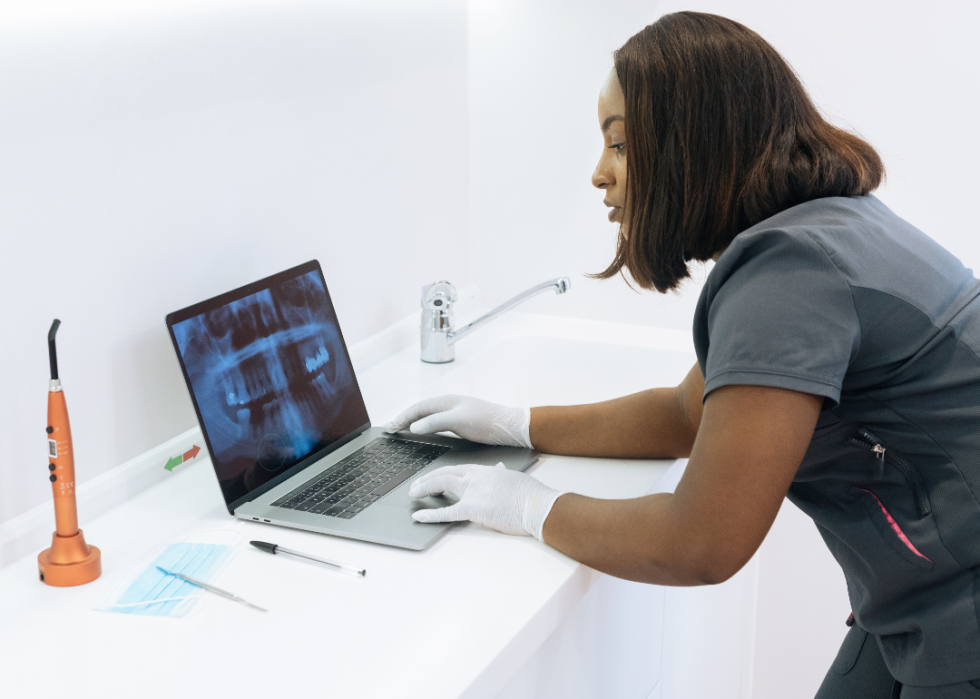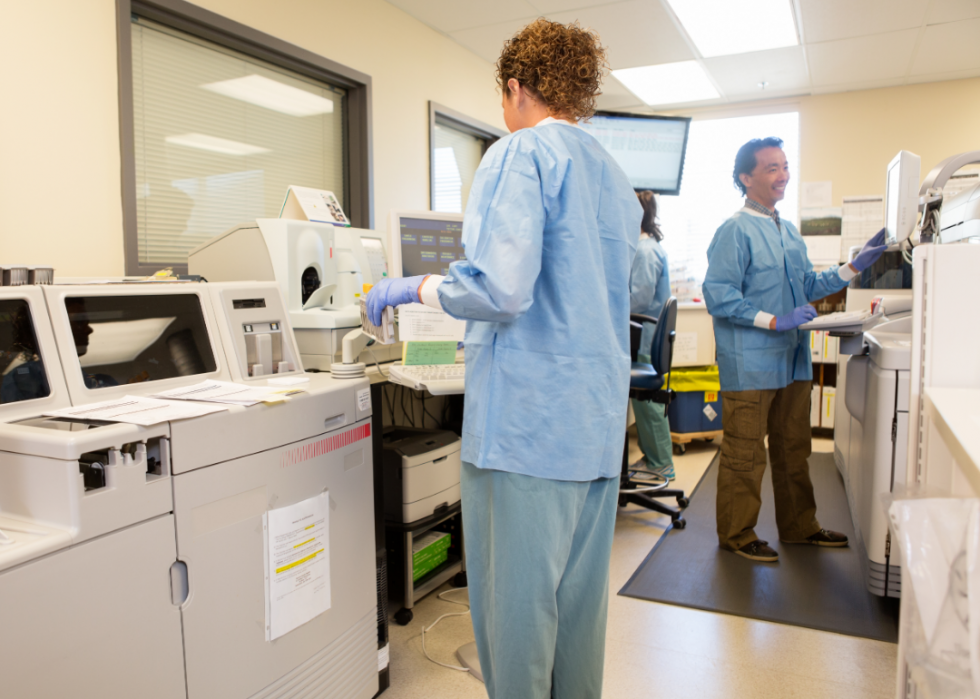
2-year degrees that go on to earn the least money
2-year degrees that go on to earn the least money
Associate degrees generally require half the academic credits of a bachelor's degree. With 20 college courses earning students 60 credits, an associate degree takes two years—half the time of a bachelor's degree. And when taken as a whole, people with two-year degrees fare better than people without them. In 2019, those with associate degrees had a median weekly earnings of $887, while those with high school diplomas earned less, $746 per week, according to the Bureau of Labor Statistics.
But there are a vast number of associate degrees, with many graduates going on to earn less money than that median of $887 per week. Those interested in earning a two-year degree should look carefully at both the projected salaries and the future demand of a chosen field. And while some careers see workers earn more money after years in their fields, some pay stalls out, with little increase over time.
Stacker compiled a list of two-year degrees whose graduates go on to earn the least money using 2020 data from Payscale. It ranked the degrees by mid-career median earnings, with ties broken by early-career median earnings.
Some degrees, like early childhood education, are an example of associate degrees that are most helpful as stepping stones toward bachelor's degrees. While associate degrees are more affordable than bachelor's, the degrees on this list demonstrate that one must consider the cost-benefit analysis of future earnings.
Demands for some of the jobs on the list have dropped. The outlook for photographers is in decline and is expected to drop by 4% between 2019 and 2029—equivalent to 4,800 fewer photography jobs—according to the Bureau of Labor Statistics. On the other hand, some jobs requiring associate degrees are growing in demand. Those looking for an associate degree in a field that promises future job security would do well to look at the jobs where the Bureau of Labor Statistics projects increasing demand, such as dental assistants, a career expected to grow by 7% until 2029, with an increase of 23,400 jobs.
Keep reading to see which two-year degrees yield the lowest wages.

#50. Dental assisting
- Mid-career median pay: $46,100
- Early career median pay: $35,700
Dental assistants help dentists by sterilizing instruments, updating dental records, and explaining oral health care to patients. They may prepare patients for surgery, take dental impressions or X-rays, assist with fillings or crowns, and operate monitors. The demand for dental assistants is expected to grow through 2029, a faster than average increase.

#49. Humanities
- Mid-career median pay: $46,100
- Early career median pay: $33,700
A humanities program typically offers a well-rounded education of literature, arts, science, and math. It is a popular offering at the associate degree level. The number of students in associate degree programs earning a degree in the humanities was substantially higher than in bachelor’s programs, according to the American Academy of Arts and Sciences. Critical thinking, writing, speaking, and reading are all key skills that carry over to a wide range of professions, the academy notes.

#48. Art & design
- Mid-career median pay: $46,100
- Early career median pay: $33,400
Programs in art and design offer concentrations in such areas as interactive media, digital design, illustration, and game design. Students prepare for careers in packaging, advertising, and publications, using both traditional and digital skills. In game design programs, they might learn programming languages employed by professional designers or develop skills in interactive design and animation.

#47. Nutrition & dietetics
- Mid-career median pay: $46,100
- Early career median pay: $33,200
Students in a program of nutrition and dietetics learn how to evaluate the role nutrition and diet can play in disease, people’s nutrition needs throughout their lives, and the nutritional value of a community’s diet, and can even learn about food services management. Career possibilities run the gamut from dietician in a school or community center, to food service director at a hospital or senior center, to private nutrition consultant. Dietitians typically need a bachelor’s degree but an associate degree can help students start out in the field. It is one that is expected to grow by about 8% from 2019 to 2029.

#46. Horticulture
- Mid-career median pay: $46,000
- Early career median pay: $34,200
Students of horticulture learn about growing flowers and plants. One popular branch of the field is sustainable horticulture, which takes into account soil and climate and the uses of organic fertilizer. Graduates can go on to careers in greenhouse, nursery, and garden center management; potted plant and perennial cultivation; or sales, including florist shops.

#45. Mental health counseling
- Mid-career median pay: $46,000
- Early career median pay: $32,900
A two-year degree in mental health counseling can ground students in the basics of the field and prepare them to continue on to a bachelor’s degree. Graduates with an associate degree in psychology can find work as psychiatric aides and social services assistants, but need further education to work as a counselor.

#44. Spanish language
- Mid-career median pay: $45,200
- Early career median pay: $31,600
Even if students do not pursue Spanish beyond an associate degree, a proficiency in the language can be beneficial in a variety of careers, from business to law enforcement. Many employers are looking for bilingual staff. Students can take classes in elementary and intermediate Spanish language as well as in the literature of Latin America and Spain.

#43. Education
- Mid-career median pay: $44,800
- Early career median pay: $28,600
Many jobs in education will require more advanced degrees, but an associate degree can introduce students to principles of education, especially for younger children. Jobs are available in daycare, preschool, and elementary schools, for example as an assistant to children with special needs or as an early childhood assistant. Some courses students might take include how children develop language, or literacy in a bilingual program.

#42. Administrative assistant & secretarial science
- Mid-career median pay: $44,600
- Early career median pay: $30,400
An associate degree could lead to a position as an executive administrative assistant, with more responsibilities than a secretary or administrative assistant would have. An executive administrative assistant purchases supplies, edits documents, supervises clerical workers, or manages executives' schedules. An office management associate degree program might teach computer technology, document sharing, or business ethics.

#41. Bookkeeping
- Mid-career median pay: $44,300
- Early career median pay: $34,900
Bookkeepers perform payroll and other financial functions for companies or nonprofits and check records for accuracy. Although they typically do not need a four-year degree, they are expected to have basic knowledge of math, computers, spreadsheets, and bookkeeping software. Most bookkeeping, accounting, and auditing clerks have some education past high school.

#40. Broadcast communication
- Mid-career median pay: $44,300
- Early career median pay: $31,800
An associate degree in broadcast communication would cover the basics of radio and television broadcasting, relevant regulations, and a history of the field. Many jobs will require a bachelor’s degree, but some more technical ones might not, particularly if students gain significant experience through internships. One example would be a camera operator.

#39. Small-business management
- Mid-career median pay: $44,100
- Early career median pay: $37,200
A two-year degree in small-business management offers the basics of business education and enables students to decide whether to continue on in the field. Small businesses are the backbone of the economy. According to the Congressional Research Service, small business startups seem to play a significant role in net job creation. That’s particularly true for businesses with at least 20 employees and those in operation for one to five years.

#38. Studio art
- Mid-career median pay: $43,700
- Early career median pay: $27,000
An associate degree would provide an education in the fundamentals of studio work, an overview of art history, and the basics of applied and fine arts. Typical areas of study include drawing, painting, sculpture, and illustration. Internships in museums or galleries help students gain experience helpful for finding jobs.

#37. Massage therapy
- Mid-career median pay: $43,500
- Early career median pay: $37,000
Students in two-year programs learn both technique and knowledge about physiology in preparation for working on their own or as part of teams in health care or sports. Demand is high, according to the American Massage Therapy Association: A survey that it conducted found that 43% of Americans who got a massage between 2016 and 2017 did so for pain management, injury rehabilitation, or some other medical or health reason.

#36. Visual arts
- Mid-career median pay: $43,500
- Early career median pay: $29,700
Students in an associate degree program in visual arts study such topics as art history, painting, figure drawing, ceramics, printmaking, and sculpture. Some might have a modern twist, such as digital photography or computer art. Students put together portfolios that are needed for more advanced study and may also prepare for jobs in the arts, in graphic design, illustration, or game design.

#35. Animal science
- Mid-career median pay: $43,500
- Early career median pay: $29,500
This degree prepares students for entry-level jobs involving farm animals. They will learn how to evaluate and handle livestock, what nutrition they need, and what veterinary care will keep them healthy. They will be familiar with housing the animals and with their reproduction. Potential careers students would be eligible for include meat inspector, feed salesperson, manager of a barn or ranch, and pharmaceutical salesperson.

#34. Health care management
- Mid-career median pay: $43,400
- Early career median pay: $35,100
Students in this field learn how to keep patient records and become familiar with medical coding. Among jobs they might pursue are medical records technician or a medical assistant. According to the Urban Institute, the number of adults 85 and older will nearly quadruple between 2000 and 2040, and as the population ages, the need for health care workers rises.

#33. Administration
- Mid-career median pay: $43,300
- Early career median pay: $32,500
An associate degree in business administration will prepare students for such jobs as a team leader and for such tasks as ordering supplies and recordkeeping. Programs may emphasize developing skills in teamwork, leadership, or problem-solving, and focus on an array of businesses, among them hotels, health clubs, stores, and other small businesses.

#32. Medical coding
- Mid-career median pay: $43,200
- Early career median pay: $34,100
An associate degree focused on medical coding can land students jobs in hospitals, clinics, or doctors’ offices. They learn to navigate today’s sophisticated technology to create accurate electronic health records and protect patient privacy. The American Health Information Management Association offers an exam to become a certified coding associate.

#31. Entrepreneurship
- Mid-career median pay: $43,200
- Early career median pay: $31,500
This course of study can apply to anyone who has ever wanted to start their own business. Students can learn how to lessen the risk of failing when they start a business, a problem for small businesses. According to the Bureau of Labor Statistics, roughly one-third of all small businesses fail within two years, and half within five years.

#30. Office administration
- Mid-career median pay: $42,600
- Early career median pay: $29,900
Administrative assistants can find positions in businesses and government offices, particularly if they are familiar with office information systems and proficient in the use of a computer. An associate degree program might offer classes in computer systems and software programs, business correspondence, business ethics, business forms, and business terminology.

#29. Medical secretarial science
- Mid-career median pay: $42,400
- Early career median pay: $27,500
Medical secretaries do the same clerical and administrative tasks as secretaries but must also be knowledgeable about medical terminology, federal and state regulations governing patient privacy, and medical procedures. They might transcribe medical reports, organize patients’ medical histories, and process insurance claims. The Bureau of Labor Statistics forecasts all jobs in the health care field to grow 15% from 2019 to 2029, much faster than the average across occupations.

#28. Graphic arts
- Mid-career median pay: $42,100
- Early career median pay: $37,900
A course in graphic arts shows students how to create illustrations or logos, a growing field, especially online. The demand for graphic artists is expected to drop 4% from 2019 to 2029, according to the Bureau of Labor Statistics, so jobs will be competitive. Degree programs typically offer concentrations in advertising, publication, or package design, and teach students in such areas as drawing and typography.

#27. Radio & television
- Mid-career median pay: $42,000
- Early career median pay: $30,600
Students will learn how to write scripts and shoot and edit broadcasts. Classes for an associate degree in radio and television can cover such topics as scripts, diction, storytelling, recording techniques, and television and radio production. As more outlets make use of drones, students will learn how to operate them. There also are courses in sales.

#26. Office management
- Mid-career median pay: $42,000
- Early career median pay: $30,400
Students of office management will learn the skills necessary to work in a technologically modern office, interacting remotely with colleagues in other locations, performing tasks electronically, and integrating smartphones, tablets, and other top-of-the-line equipment. Jobs are available in business, education, public organizations, and nonprofits. Some courses students might take include business writing, spreadsheets, and workplace mathematics.

#25. Health & medical services administration
- Mid-career median pay: $41,300
- Early career median pay: $29,600
An associate degree in health and medical services administration introduces students to the growing health care field, with such key topics as medical terminology, regulations governing patient privacy, American health care systems, and policies that affect health care. They will examine the ways in which the country provides both private and public health care.

#24. Veterinary technology
- Mid-career median pay: $41,000
- Early career median pay: $30,600
Students in veterinary technology programs can go on to become licensed veterinary technicians after studying basic skills for use in clinics or veterinary hospitals. They learn how to take an animal’s medical history, perform a physical exam, identify different breeds of animals, and administer medicines. They study nursing care and treatment for trauma, poisoning, and other emergencies.

#23. Medical billing & coding
- Mid-career median pay: $40,500
- Early career median pay: $31,500
This program offers a career path to one of the less visible jobs that are nonetheless key to excellent medical care. Students learn to process bills for patients and to keep accurate records, and they study health insurance and the billing procedures. The job outlook for the field is good, according to the Bureau of Labor Statistics, which projects growth of about 8%, higher than average, as the U.S. population grows older.

#22. Pharmacy
- Mid-career median pay: $40,400
- Early career median pay: $27,700
Pharmacy technicians prepare prescriptions with supervision and might take patient information and process insurance claims. The field is another one that is expected to grow as Americans grow older and make more use of health care. The Bureau of Labor Statistics expects a 4% increase in the profession, which is about average. Courses cover the basics of pharmacology and drug interactions.

#21. Cosmetology
- Mid-career median pay: $40,300
- Early career median pay: $24,700
An associate degree in cosmetology covers classes in hairdressing, nail care, skin care, and waxing. Students can pursue careers in skin care as makeup artists or those involving laser techniques. They learn about anatomy and physiology, the biology of the skin, bacteria and safety, and chemistry. They also study business practices as they relate to the cosmetology field.

#20. Chemical dependency counseling
- Mid-career median pay: $40,200
- Early career median pay: $34,100
Students who earn an associate degree in chemical dependency counseling can find jobs as entry-level counselors dealing with alcohol and substance abuse; caseworkers; educators; and specialists working in the community. Those jobs might be in youth centers, jails or prisons, alcohol and drug rehabilitation centers, senior centers, or community centers.

#19. Human services
- Mid-career median pay: $40,200
- Early career median pay: $31,000
An associate degree in human service can cover a wide range of fields. Social services assistants help social workers and psychologists working with everyone from children and immigrants to prisoners or those struggling with substance abuse. Community service managers run programs that provide social services to those in need of food, housing, or jobs.

#18. Hospitality & the culinary arts
- Mid-career median pay: $39,900
- Early career median pay: $31,500
An associate degree in hospitality would cover such areas as travel and tourism, managing a hotel or inn, and managing a restaurant, along with the basic accounting skills needed for the field. The culinary arts portion of a degree would focus on food and beverages for hotels, catered events, or schools and other institutions.

#17. Elementary education
- Mid-career median pay: $39,900
- Early career median pay: $27,200
Although teachers require at least a bachelor’s degree, those with an associate degree in elementary education could get a chance to observe the career from inside the classroom and decide whether to pursue further education. Degree-holders can often find work in preschools and daycare centers or as teachers’ assistants, using their classroom background in child development and the basics of education.

#16. Pre-pharmacy
- Mid-career median pay: $39,700
- Early career median pay: $27,800
A pre-pharmacy associate degree prepares students to pursue a bachelor's degree and other advanced degrees in the field. Such programs typically cover basic math and science needed for the profession. Typical classes might include cellular biology, calculus, chemistry, and statistics. Students perform lab experiments and learn scientific methods to analyze problems.

#15. Medical assisting
- Mid-career median pay: $39,500
- Early career median pay: $30,100
Graduates with an associate degree in medical assisting are prepared for clinical, laboratory, and office work. They learn skills to use in a clinic or laboratory, and can help in a variety of ways. They can collect laboratory specimens, draw blood (phlebotomy), take electrocardiograms, record vital signs and medical histories, and ready patients for examinations.

#14. Office systems technology
- Mid-career median pay: $39,100
- Early career median pay: $29,300
Courses that are part of an office systems technology degree teach the integration of computer applications such as word processing and multimedia; introduce business financial systems; and expose students to electronic spreadsheets and records management. Students might also take classes in accounting and management, and learn how to produce documents and use multimedia for business presentations.

#13. Pastry & culinary arts
- Mid-career median pay: $39,100
- Early career median pay: $27,700
An associate degree specializing in pastry and culinary arts teaches would-be chefs the basics of classic food preparation as well as more modern techniques. They learn how to create menus, incorporate dishes from around the world, and run a successful restaurant or perhaps a food truck. The pastry arts part of the degree focuses on pastries, of course, but also perhaps chocolates or breads. Students can gain the experience to open a bakery or a cafe.

#12. Special education
- Mid-career median pay: $39,100
- Early career median pay: $27,600
Students with an associate degree in this field can work as a teaching assistant for children with special needs. They will learn about childhood development and also developmental disabilities and strategies to help the children learn. Students will also have the classroom experience if they are considering whether to continue on with advanced degrees to become a special education teacher.

#11. Mental health
- Mid-career median pay: $38,500
- Early career median pay: $28,100
An associate degree in mental health will give a graduate flexibility in pursuing a variety of jobs in the field, from alcohol and substance abuse counseling to hospice care. Graduates might find work in alcohol and substance abuse rehabilitation centers, mental health care departments of local government, schools, or community mental health care centers.

#10. Medical insurance billing & coding
- Mid-career median pay: $38,400
- Early career median pay: $30,300
This career focuses specifically on billing and coding for insurance purposes to ensure that patients are able to get covered for their care. Students learn about insurance terminology, insurance plans, government health care programs, and federal regulations, particularly as they relate to patient privacy. The field in general is growing, according to the Bureau of Labor Statistics, which projects growth of about 8%, higher than average, as the U.S. population grows older.

#9. Social services
- Mid-career median pay: $38,000
- Early career median pay: $34,100
Careers in the social service sector are wide-ranging, and can include working within programs that provide services like education, health care, public services like firefighting and law enforcement, food subsidies and subsidized housing, and more. These programs can be found across government agencies and within for-profit and nonprofit organizations.

#8. Administrative medical assistant studies
- Mid-career median pay: $36,400
- Early career median pay: $29,800
Graduates in the field of medical office administration can typically find work in doctors’ offices, hospitals, nursing homes, rehabilitation centers, and similar medical facilities. They are responsible for clerical and other tasks. The job outlook is good, according to the Bureau of Labor Statistics. Job growth is expected to rise 19% from 2019 to 2029, a much quicker pace than the average for all occupations.

#7. Medical transcription
- Mid-career median pay: $36,400
- Early career median pay: $28,800
A medical transcriptionist typically takes a doctor’s audio notes about patients and transcribes them onto a computer. They must be familiar with medical terminology as well as the diagnoses, procedures, and treatments that doctors might cover as well as commonly used abbreviations. The outlook for the field is not good, however, according to the Bureau of Labor Statistics. Demand is expected to drop 2% between 2019 and 2029.

#6. Pharmacy technology
- Mid-career median pay: $36,400
- Early career median pay: $28,000
Students in the field of pharmacy technology learn to identify the names and uses of prescription drugs and over-the-counter medications and to understand and identify symptoms of misuse. They will study ethical behavior in the field and should be prepared to become an entry-level pharmacy technician and pass the National Pharmacy Technician Certification Examination.

#5. Early childhood & elementary education
- Mid-career median pay: $35,000
- Early career median pay: $27,700
To actually teach, a graduate would need to continue on to at least a bachelor’s degree, but with an associate degree in this field, they can get hired in preschools, daycare centers, and schools as teachers’ assistants. An associate degree in elementary education provides a strong background in working with children who are special learners, drawing up instruction plans, and learning about child development.

#4. Social work
- Mid-career median pay: $34,700
- Early career median pay: $29,900
An associate's degree in social work does not enable a graduate to become licensed as a social worker, but it does open up some career options, among them human services positions. The degree could also form the basis of an eventual bachelor’s degree, opening the door to many more career choices. Typical classes include introductions to social work, counseling, and abnormal behavior.

#3. Phlebotomy
- Mid-career median pay: $34,200
- Early career median pay: $29,600
A phlebotomy technician has the responsibility of drawing blood samples from patients or from blood donors and then preparing the samples for laboratory testing. Training emphasizes the need for a caring, compassionate demeanor to put patients at ease. The Bureau of Labor Statistics predicts high demand for technicians skilled in phlebotomy, expecting a 17% growth in the field from 2019 to 2029, much higher than the 4% average for all fields.

#2. Child development
- Mid-career median pay: $34,000
- Early career median pay: $26,800
Child development is a key component of any program in early childhood education and teaches students how to encourage young children intellectually and emotionally. Students explore a child’s language and literacy development, learning through play, and overall growth and development. They work with children up to the third grade.

#1. Early childhood education
- Mid-career median pay: $32,800
- Early career median pay: $26,200
An associate degree in this field can introduce students to the field, though those aspiring to become teachers require at least a bachelor's degree. Those with an associate degree in early elementary education will be in a better position to decide whether to pursue more education. They can often get hired in preschools and daycare centers or as teachers' assistants using their background in development and strategies for instruction.



